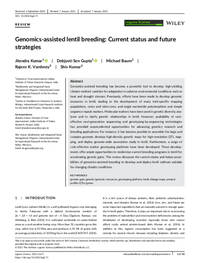Genomics-assisted lentil breeding: Current status and futurestrategies

Authors:
Genomics-assisted breeding has become a powerful tool to develop high-yielding climate-resilient varieties for adaptation to adverse environmental conditions such as heat and drought stresses. Previously, efforts have been made to develop genomic resources in lentil, leading to the development of many trait-specific mapping populations, cores and mini-cores, and single nucleotide polymorphism and simple sequence repeat markers. Molecular markers have been used in genetic diversity analyses and to clarify genetic relationships in lentil. However, availability of cost-effective next-generation sequencing and genotyping-by-sequencing technologies has provided unprecedented opportunities for advancing genetics research and breeding applications. For instance, it has become possible to assemble the large and complex genome, develop high-density genetic maps for high-resolution QTL mapping, and deploy genome-wide association study in lentil. Furthermore, a range of cost-effective marker genotyping platforms have been developed. These developments offer ample opportunities to modernize current breeding programs in lentil for accelerating genetic gains. This review discusses the current status and future possibilities of genomics-assisted breeding to develop and deploy lentil cultivars suitable for changing climatic conditions.
